Fostering Sustainable Fashion Innovation: Insights from Ideation Tool Development and Co-Creation Workshops
Abstract
:1. Introduction
2. Literature Review
2.1. The Design Process in the Fashion Industry
2.2. The Provision of Sustainability Information as MCS
2.3. Design for Sustainable Fashion Innovation
2.4. Sustainable Fashion Bridges
2.4.1. Toolkit Vision and Structure
2.4.2. Toolkit Content
3. Research Methods
3.1. Design Thinking and Co-Design Workshop
3.2. Data Collection and Analysis
3.3. Interview-Based Evaluation
4. Results
4.1. Evaluation of the Toolkit and Workshop Process
“The mind mapping process helps narrow down the specific problems through writing down the keyword. It allows the identification of the key solution to work on a new concept logically. It really helps to bring out lots of ideas from the ideation cards and write down a core solution through the mapping system. It identifies key elements and looks at the co-relation of each idea, which triggers innovation and helps us to bounce ideas off each other”(W2)
4.2. Interview-Based Evaluation
“A lot of companies and organisations need to take knowledge from the design sphere. For the design consultancy, a more multi-disciplinary team including designers, pattern makers, technologists, buyers, merchandisers, marketers, and managers sitting down and developing strong design strategies would be very valuable. They often need to develop a better understanding of where they are going and what the real future concerns are”.(P11)
“I think it is thought-provoking, especially if you are in a brand or if a lot of brands need to reposition the way their internal business strategy is, for it to be sustainable. If they chose to start it small, they wouldn’t need to go through every single option. Even when they look at one set of cards, they can positively impact future environments. There is so much pressure on brands everywhere to be more sustainable, to change the way that their business works. A lot of people have no idea where to start, but this makes it really simple, so you can just pick a card or flip through trying to find ways to adjust your business to be more sustainable”(P4)
4.3. Suggested Improvements and Other Aspirations for Tool Usage
5. Discussion
5.1. Roles of MCSs in Sustainable Fashion Innovation
5.2. Sustainability Skills and Sustainable Fashion Education
5.3. Using Design Thinking and Co-Creation for Sustainable Innovation
- (1)
- Sustainability beginners with low levels of sustainability skills and no design experience or design implication skills.
- (2)
- Sustainability analysts with high levels of knowledge and skills in sustainable fashion, but no design experience or design implication skills.
- (3)
- Fashion products–service systems (PSS) designers with low levels of knowledge and sustainability skills, but high levels of experience in design implementation.
- (4)
- Sustainable fashion innovation specialists with high levels of sustainability skills, and engagement in sustainable fashion and design implementation.
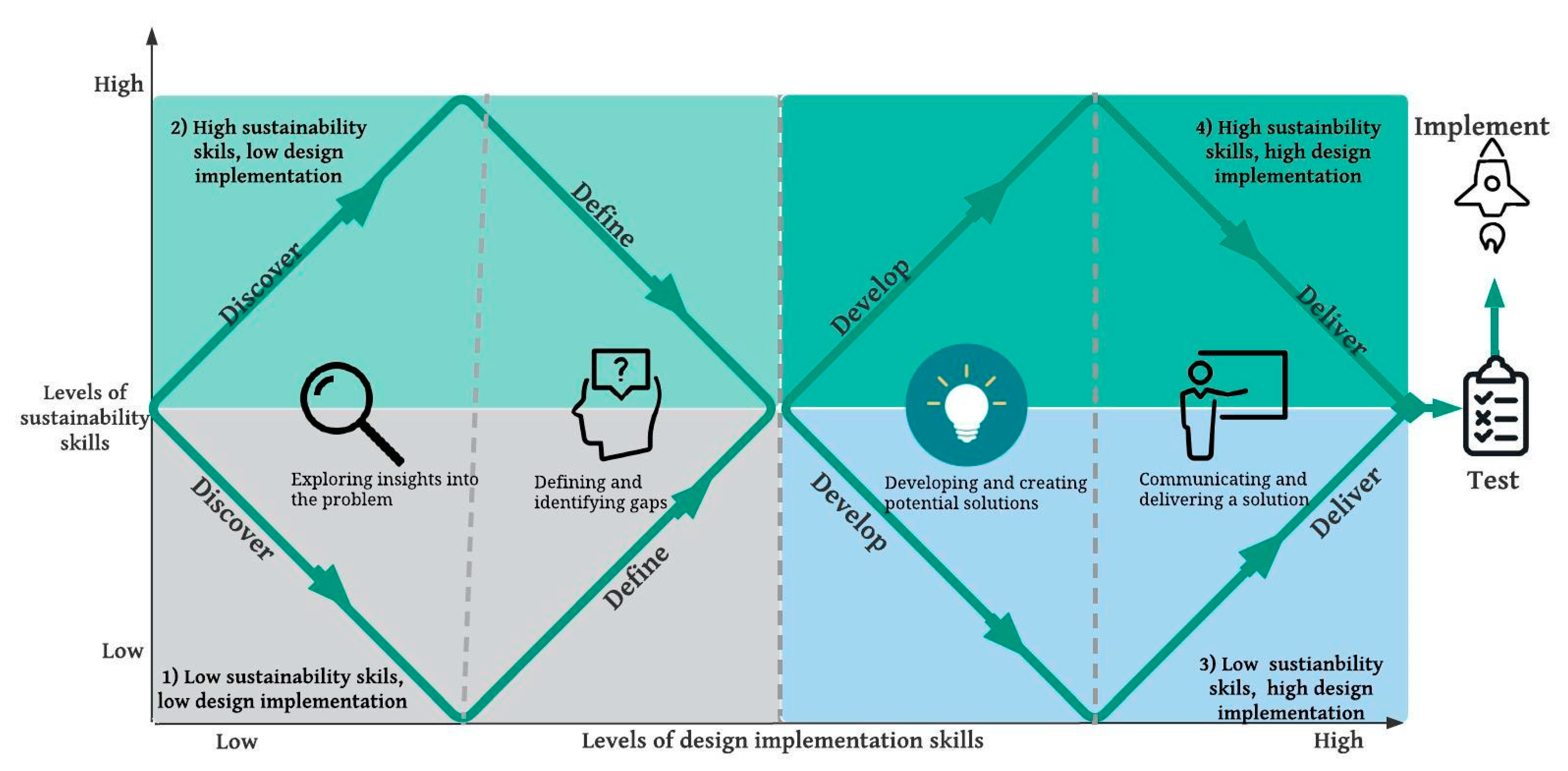
- (1)
- The beginner level for co-creators: Those who have little or no experience participating in design implementation activities and who have a low level of knowledge and skills in sustainable fashion. This group can share their experiences with barriers to pro-environmental actions and their perceptions and experiences of sustainable fashion products and services from a consumer perspective. General consumer groups can offer valuable insights during the discovery stage of the DT process by sharing their product and service experiences, issues, and their needs for sustainable fashion. A number of possible issues could be explored using divergent thinking at the beginning of the design process by looking at the issues related to sustainability in fashion production and consumption and consumers’ behaviours with the fashion products and service interactions.
- (2)
- High sustainability skills and low design implementation: In this group, participants may have a good ability to engage in pro-environmental behaviours and have good knowledge of sustainable fashion, but not much experience with design practices. Participants can define the key issues of sustainability as they relate to fashion. Convergent thinking can be used to narrow down and define key problems by identifying themes and finding connections and relationships with the issue. In this stage, co-design participants can explore design implementation possibilities to tackle the identified problem.
- (3)
- Low sustainability skills and high design implementation: People in this group generally have low levels of knowledge of and engagement with sustainable fashion, but high levels of experience in design implementation. Some fashion design participants expressed that they would have preferred to move directly on to the next step in the fashion design process, with a hands-on experience of garments to assist in the generation of solutions. The making and crafting process is a pivotal aspect of fashion design implementation. Reflecting the consequences and environmental and social issues of the fashion production process, co-designers could implement better design solutions by addressing environmental and social impacts throughout the clothing life cycle.
- (4)
- High sustainability skills and high design implementors: Participants described in the top right quadrant are fully conversant in both sustainability issues. They also have the ability to implement the conceptual sustainability ideas of design practices in real-world contexts. Designers can share their knowledge and skills with users by actively involving rapid prototyping and micro-production services.
5.4. Future Directions for the Sustainable Fashion Innovation Tool
6. Conclusions
Author Contributions
Funding
Institutional Review Board Statement
Informed Consent Statement
Data Availability Statement
Acknowledgments
Conflicts of Interest
Appendix A. Open-Ended Questions: Choice, Optimisation, and Social Conversation Patterns
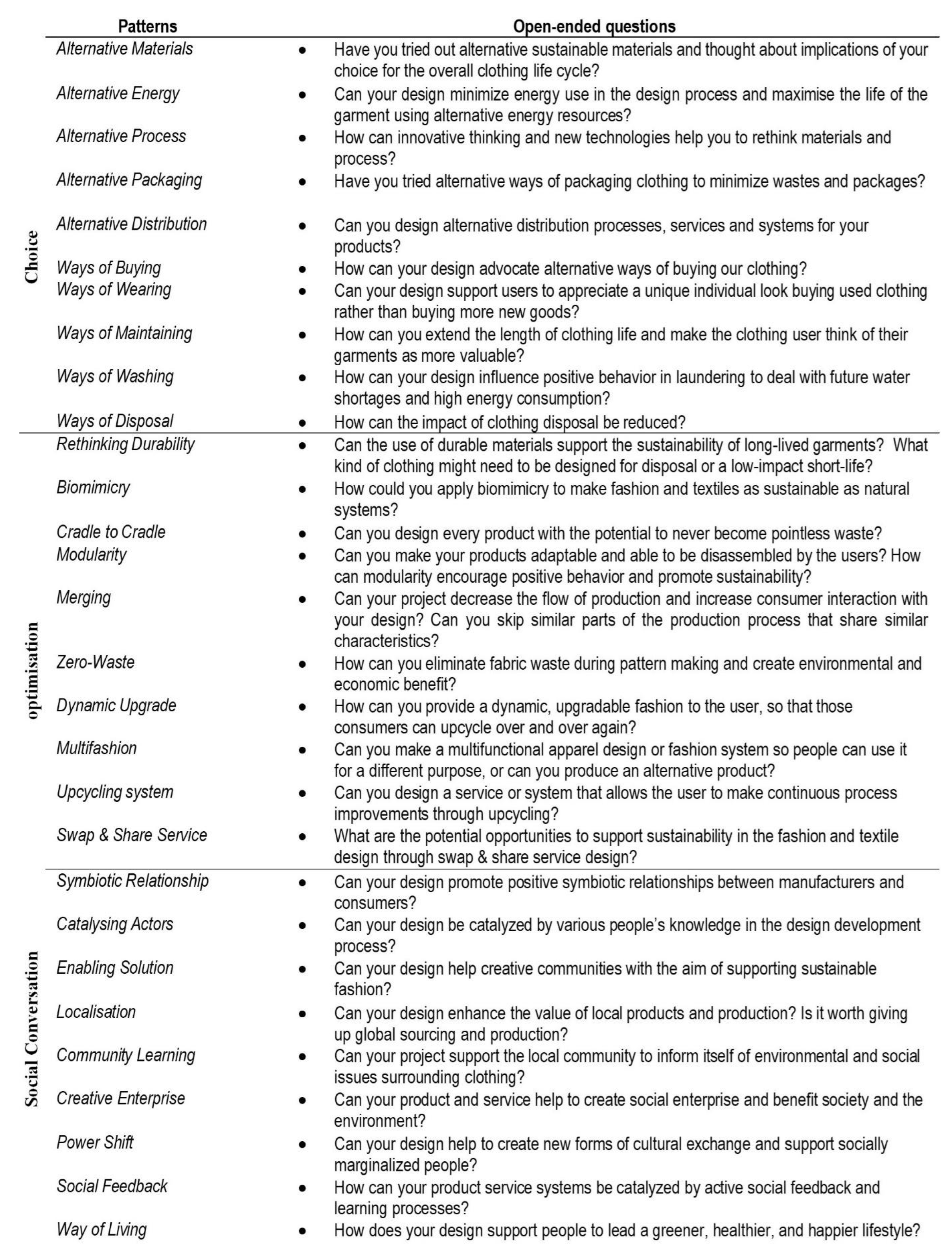
Appendix B. Open-Ended Questions: Empowerment, Persuasion, and Interaction Patterns
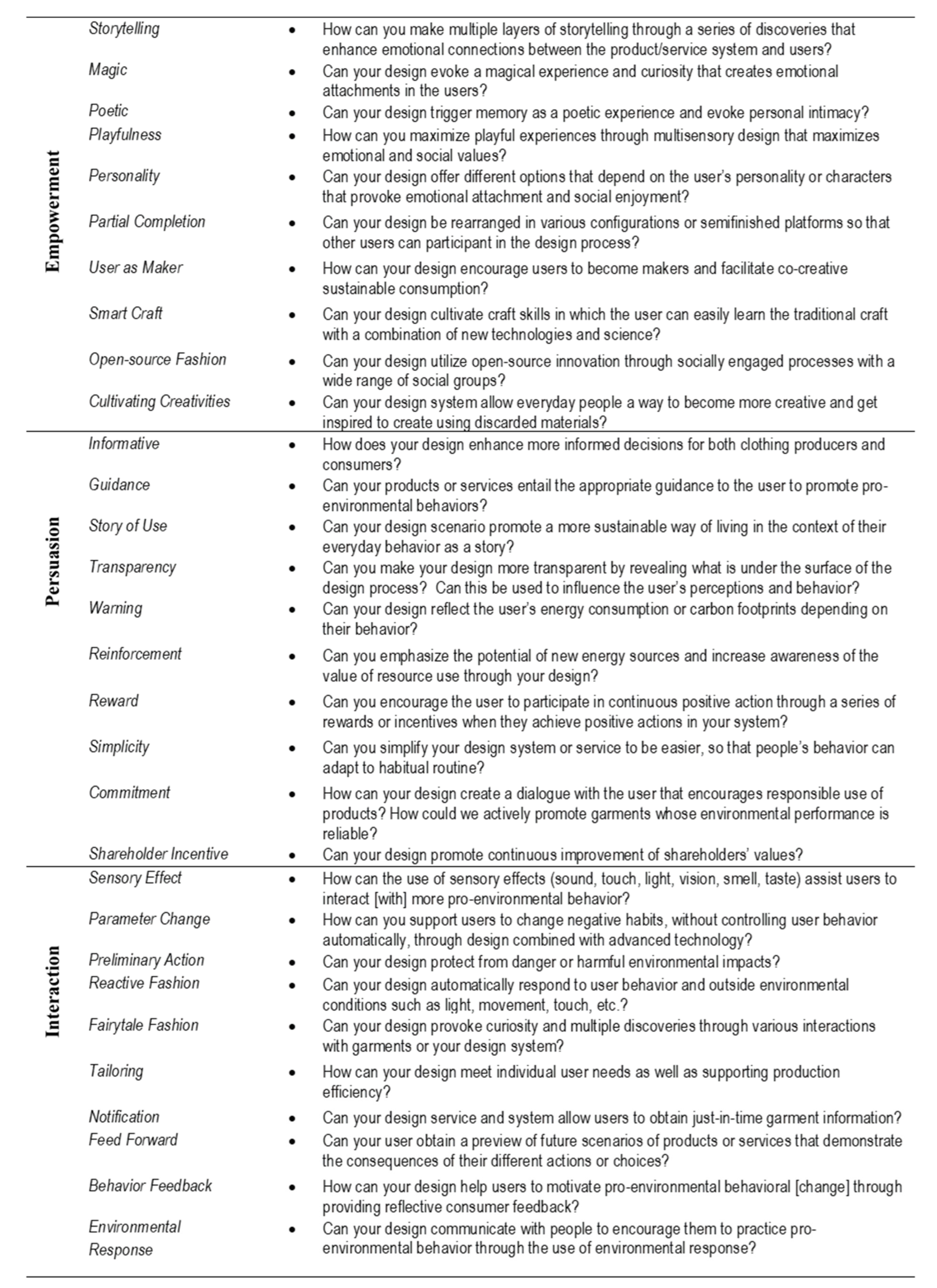
Appendix C. A Summary of Participants’ Perspectives on Each Card Pattern
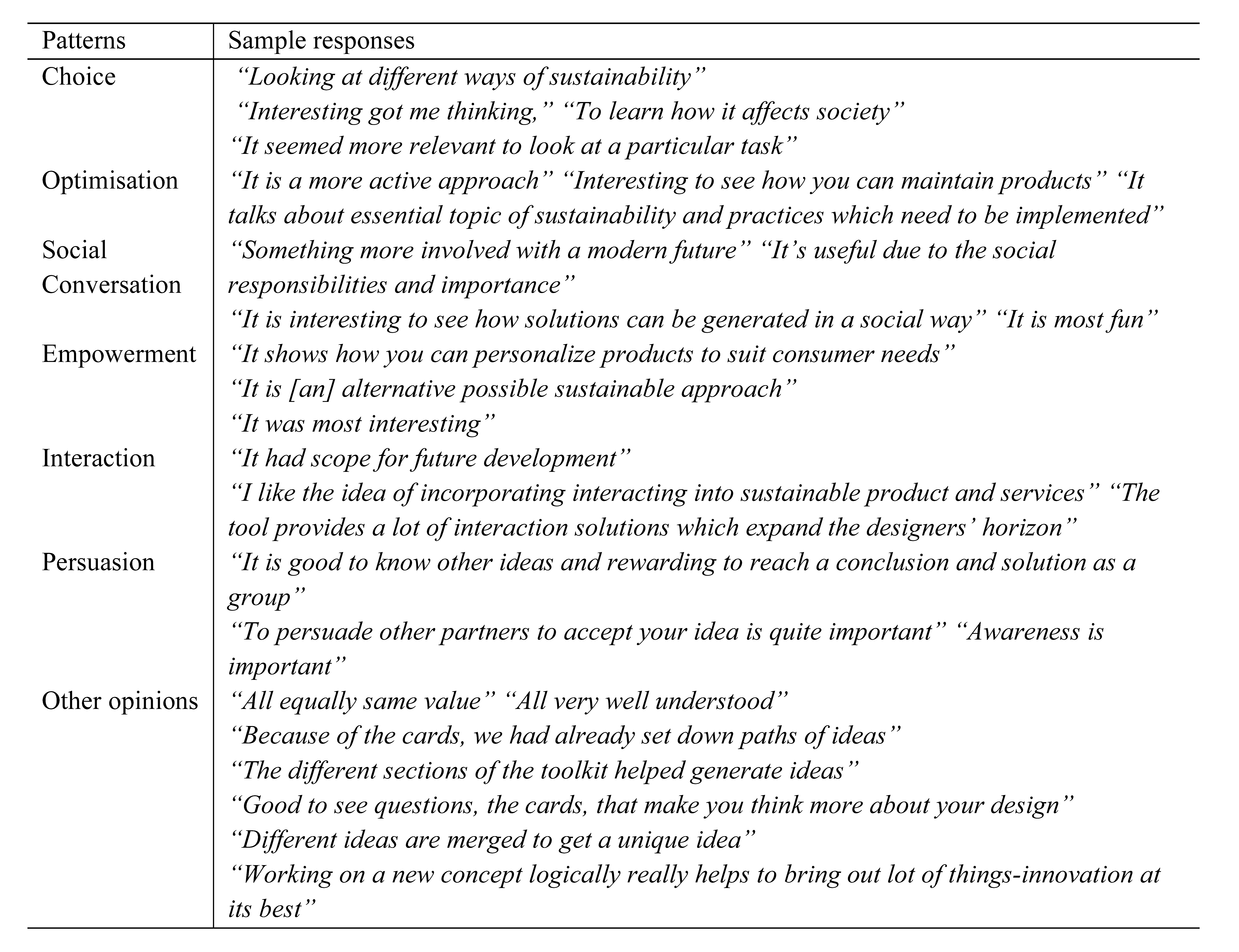
Appendix D. Workshops: Idea Evaluation and Critical Reflection
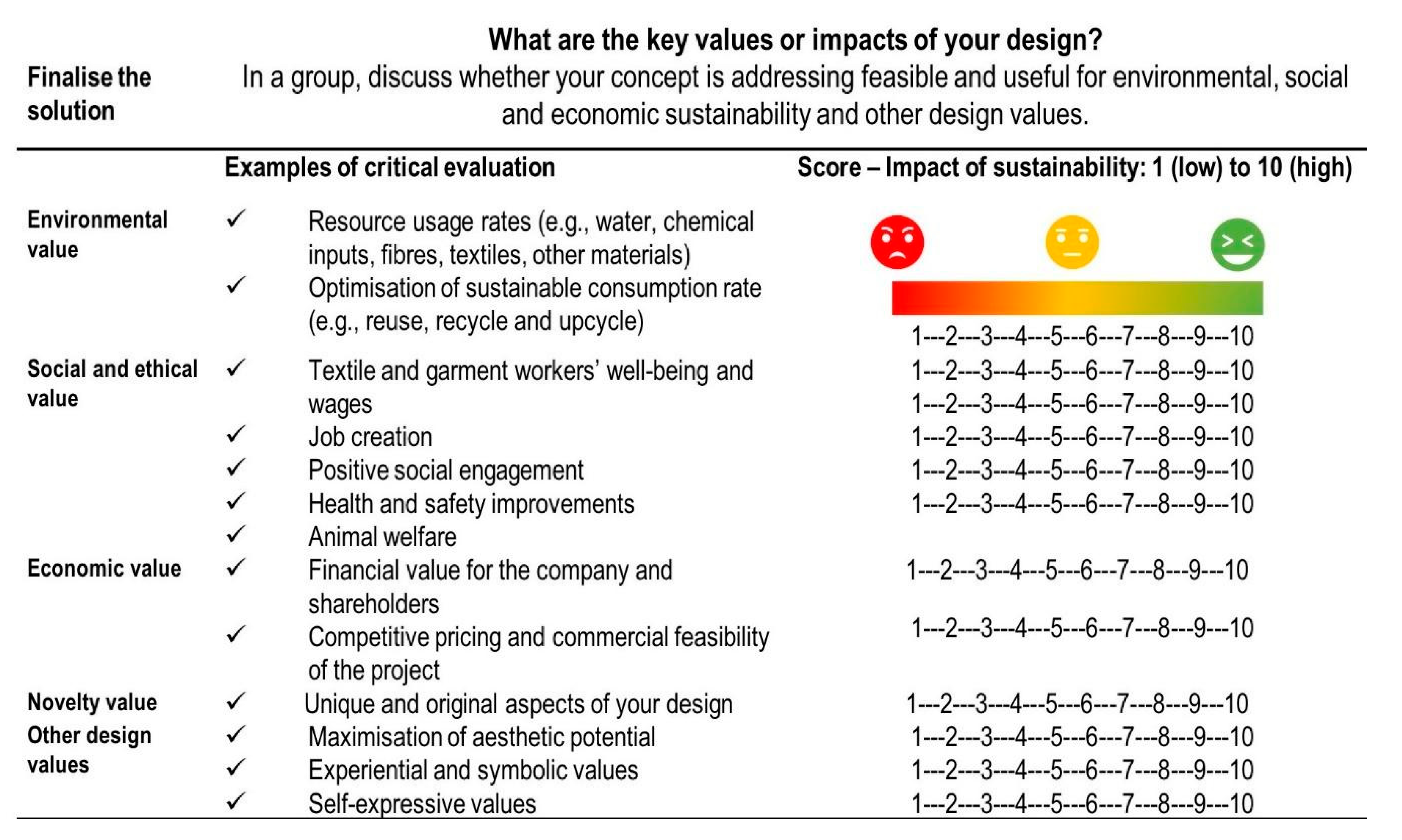
Appendix E. Examples of User-Generated Concepts from Workshops
| Group | A | B |
| Idea visualisation | 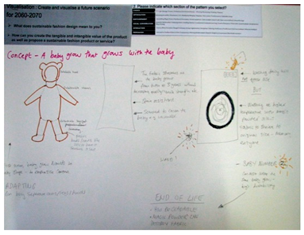 | 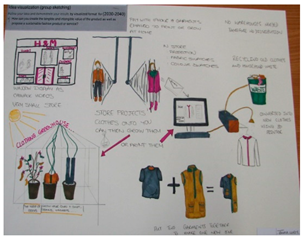 |
| Target market | Babies and parents | Online and offline shoppers |
| Identified issues and needs | Babies grow very quickly and their parents need to buy new garments too often | Lack of personalisation and personal experience in conventional shopping stories |
| Suggested design solutions | New product design and product–service systems (PSS) for babies. To solve this problem, after participants selected the alternative material and modularity cards, they suggested designs for baby clothing by observing users’ behaviours. The garments can be detached or separated for different purposes and, because they used stretch fabric, when a baby grows, the garment grows with them. PSS allows parents to share and buy second-hand children’s products instead of buying new ones that require only short-term use. | Retail shops can cater to individual users’ needs by changing the ways users’ shop, providing alternative, higher quality, and smart fabric selections. Incorporating the idea of smart DIY fashion, consumers could buy fabrics and colour swatches with video instructions. The consumer could then design and produce the garment at home, emphasising self-sufficiency and effective communication with consumers. The manufacturing process would need to be more transparent; fashion companies sell various services, including knowledge, ideas, and production qualities. Production and consumption processes would be continually improved based on an effective consumer feedback loop. |
| Group | C | D |
| Idea visualisation |  | 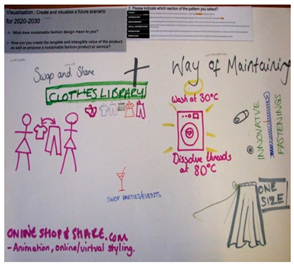 |
| Target market | Local communities | Local communities |
| Identified issues and needs | Lack of accessibility of personalised design in local community | Lack of local clothing-sharing services and communities |
| Suggested design solutions | This group considered that the way to achieve sustainable fashion is through good quality design. Participants selected the ‘tailoring’, ‘user as a maker’, and ‘shareholder incentive’ cards. Participants suggested a community project that collaborates between a tailor/designer and a local or supermarket retailer by bringing expertise to an assessable level. A tailor/designer-run workshop for the local community would foster more personalised styles and looks using high-quality and sustainable materials. | An online platform for a global swap and share service with local communities. The clothing library can be activated from community to community and sell the intangible value of the services. Furthermore, various users can wear versatile, one-size clothing without size limitations. |
| E | F | |
| Idea visualisation | 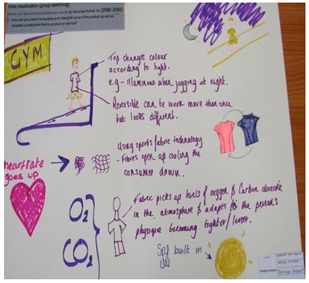 | 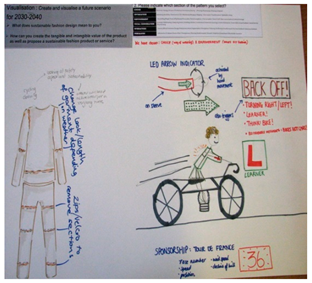 |
| Target market | Consumers who are concerned about wellness and sustainability | Future bicyclists |
| Identified issues and needs | Lack of function in clothing (safety, comfort, utility) and consumers’ emotional and behavioural interactions with products | Lack of flexibility, comfort, and safety elements in clothing for night-time bicyclists |
| Suggested design solutions | Garments can offer protection from pollution and react to the climate, such as wind, sun, and rain. Adaptable, UV-resistant, waterproof, breathable fabric has reacting fibres that can expand and contract responding to the temperature and weather. The clothing also reacts depending on the wearer’s movement and temperature and how they are breathing. Garments can react to different senses (smell, sound, touch). When people are hugging, the garments can interact with the wearers to enhance a couple’s relationship. | To encourage safe motorcycle or bicycle riding, the back of the LED jacket gives an indication of the wearer’s level of cycling skills, handle movement, and speed. Incorporating the idea of design modularity and the use of zippers or Velcro, clothing can be changed; the look and length of the garment and its sections can be removed, depending on the user’s activities and temperature. The design components can be interchanged with other functions and adjusted to different sizes. The fashion company could sell sections of the modular components and provide sponsorships for safe riders. |
References
- Niinimäki, K.; Peters, G.; Dahlbo, H.; Perry, P.; Rissanen, T.; Gwilt, A. The environmental price of fast fashion. Nat. Rev. Earth Environ. 2020, 1, 189–200. [Google Scholar] [CrossRef]
- Yakupitiyage, T. Global Slavery Index 2018; Walk Free Foundation: Perth, Australia, 2018; Available online: https://cdn.walkfree.org/content/uploads/2023/04/13181704/Global-Slavery-Index-2018.pdf (accessed on 24 August 2023).
- Peake, K.; Kenner, J. ‘Slaves to Fashion’ in Bangladesh and the EU: Promoting decent work? Eur. Labour Law J. 2020, 11, 175–198. [Google Scholar] [CrossRef]
- Köksal, D.; Strähle, J.; Müller, M.; Freise, M. Social sustainable supply chain management in the textile and apparel industry—A literature review. Sustainability 2017, 9, 100. [Google Scholar] [CrossRef]
- The Guardian “Virtually Entire” Fashion Industry Complicit in Uighur Forced Labour, Say Rights Groups|Uighurs|the Guardian. Available online: https://amp-theguardian-com.cdn.ampproject.org/c/s/amp.theguardian.com/global-development/2020/jul/23/virtually-entire-fashion-industry-complicit-in-uighur-forced-labour-say-rights-groups-china?fbclid=IwAR2MagUhNckXVQb6vh2IKWuhglsJKCDox0aAzjBAS4NyNlQuZ9- (accessed on 16 December 2020).
- Environmental Audit Committee Fixing Fashion: Clothing Consumption and Sustainability-Environmental Audit Committee. Available online: https://publications.parliament.uk/pa/cm201719/cmselect/cmenvaud/1952/full-report.html#heading-6 (accessed on 3 January 2020).
- Labour Behind the Label. BooHoo and COVID-19: The People behind the Profits. 2020. Available online: https://labourbehindthelabel.net/wp-content/uploads/2020/06/LBL-Boohoo-WEB.pdf (accessed on 24 January 2022).
- UN Alliance for Sustainable Fashion UN Alliance for Sustainable Fashion. Available online: https://www.adaptation-undp.org/resources/link/un-alliance-sustainable-fashion (accessed on 23 December 2020).
- Labour Behind the Label. Follow the Thread: The Need for Supply Chain Transparency in the Garment and Footwear Industry; Labour Behind the Label: Bristol, UK, 2017. [Google Scholar]
- Fashion Revolution Fashion Transparency Index 2020; Fashion Revolution. 2020. Available online: https://www.fashionrevolution.org/about/transparency (accessed on 23 January 2023).
- Greenpeace. Detox My Fashion—Greenpeace International; Greenpeace: Amsterdam, The Netherlands, 2020; Available online: https://www.greenpeace.org/international/act/detox/#:~:text=As%20part%20of%20Greenpeace’s%20global,chemicals%20throughout%20its%20supply%20chain (accessed on 24 January 2022).
- Niu, B.; Chen, L.; Zhang, J. Punishing or subsidizing? Regulation analysis of sustainable fashion procurement strategies. Transp. Res. Part E Logist. Transp. Rev. 2017, 107, 81–96. [Google Scholar] [CrossRef]
- Rebs, T.; Brandenburg, M.; Seuring, S.; Stohler, M. Stakeholder influences and risks in sustainable supply chain management: A comparison of qualitative and quantitative studies. Bus. Res. 2018, 11, 197–237. [Google Scholar] [CrossRef]
- Roy, V.; Silvestre, B.S.; Singh, S. Reactive and proactive pathways to sustainable apparel supply chains: Manufacturer’s perspective on stakeholder salience and organizational learning toward responsible management. Int. J. Prod. Econ. 2020, 227, 107672. [Google Scholar] [CrossRef]
- Karaosman, H.; Perry, P.; Brun, A.; Morales-Alonso, G. Behind the runway: Extending sustainability in luxury fashion supply chains. J. Bus. Res. 2020, 117, 652–663. [Google Scholar] [CrossRef]
- Fletcher, K. Sustainable Fashion and Textiles; Earthscan: Oxford, UK, 2008; ISBN 9781844074631. [Google Scholar]
- Vezzoli, C.; Manzini, E. Design for Environmental Sustainability; Springer: Berlin/Heidelberg, Germany, 2008. [Google Scholar]
- Bocken, N.M.P. Sustainable venture capital-catalyst for sustainable start-up success? J. Clean. Prod. 2015, 108, 647–658. [Google Scholar] [CrossRef]
- Paulus, P.B.; Yang, H.C. Idea generation in groups: A basis for creativity in organizations. Organ. Behav. Hum. Decis. Process. 2000, 82, 76–87. [Google Scholar] [CrossRef]
- Steen, M.; Manschot, M.; de Koning, N. Benefits of co-design in service design projects. Int. J. Des. 2011, 5, 53–60. [Google Scholar]
- Sanders, L.; Simons, G. A Social Vision for Value Co-creation in Design. Open-Source Bus. Resour. 2009, 27–34. [Google Scholar]
- Bell, S.; Morse, S. Rich pictures: A means to explore the “sustainable mind”? Sustain. Dev. 2013, 21, 30–47. [Google Scholar] [CrossRef]
- Dubois, L.-E.; Le Masson, P.; Weil, B.; Cohendet, P. From Organizing for Innovation to Innovating for Organization: How Co-Design Fosters Change in Organizations; Aims: Rennes, France, 2014. [Google Scholar]
- Hur, E.; Beverley, K.; Cassidy, T. The development of an ideation toolkit supporting sustainable fashion design and consumption. Res. J. Text. Appar. 2013, 17, 89–100. [Google Scholar] [CrossRef]
- Textile Environment Design Aims Textiles Environment Design. Available online: http://www.tedresearch.net/teds-ten-aims/ (accessed on 22 December 2020).
- Kozlowski, A.; Searcy, C.; Bardecki, M. The reDesign canvas: Fashion design as a tool for sustainability. J. Clean. Prod. 2018, 183, 194–207. [Google Scholar] [CrossRef]
- Bandinelli, R.; Rinaldi, R.; Rossi, M.; Terzi, S. New product development in the fashion industry: An empirical investigation of Italian firms. Int. J. Eng. Bus. Manag. 2013, 5, 31. [Google Scholar] [CrossRef]
- Claxton, S.; Kent, A. The management of sustainable fashion design strategies: An analysis of the designer’s role. J. Clean. Prod. 2020, 268, 122112. [Google Scholar] [CrossRef]
- Davila, A.; Ditillo, A. Management control systems for creative teams: Managing stylistic creativity in fashion companies. J. Manag. Account. Res. 2017, 29, 27–47. [Google Scholar] [CrossRef]
- Cirella, S. Organizational Variables for Developing Collective Creativity in Business: A Case from an Italian Fashion Design Company. Creat. Innov. Manag. 2016, 25, 331–343. [Google Scholar] [CrossRef]
- Goworek, H. An investigation into product development processes for UK fashion retailers: A multiple case study. J. Fash. Mark. Manag. 2010, 14, 648–662. [Google Scholar] [CrossRef]
- Diaz Lopez, F.J.; Bastein, T.; Tukker, A. Business Model Innovation for Resource-efficiency, Circularity and Cleaner Production: What 143 Cases Tell Us. Ecol. Econ. 2019, 155, 20–35. [Google Scholar] [CrossRef]
- Cappetta, R.; Cillo, P.; Ponti, A. Convergent designs in fine fashion: An evolutionary model for stylistic innovation. Res. Policy 2006, 35, 1273–1290. [Google Scholar] [CrossRef]
- Hargadon, A.B.; Bechky, B.A. When collections of creatives become creative collectives: A field study of problem solving at work. Organ. Sci. 2006, 17, 484–500. [Google Scholar] [CrossRef]
- Agarwal, S. Experimental Sustainable Practices in Fashion Education. In Sustainable Development and Social Responsibility—Volume 1; Springer Nature: Cham, Switzerland, 2020; pp. 95–102. [Google Scholar] [CrossRef]
- Rana, M.R.I.; Ha-Brookshire, J. New conceptual framework for fashion business ideation, negotiation, and implementation undergraduate curricula for sustainable development. Int. J. Fash. Des. Technol. Educ. 2019, 12, 140–148. [Google Scholar] [CrossRef]
- Peirson-Smith, A.; Evans, S. Fashioning Green Words and Eco Language: An Examination of the User Perception Gap for Fashion Brands Promoting Sustainable Practices. Fash. Pract. 2017, 9, 373–397. [Google Scholar] [CrossRef]
- Palomo-Lovinski, N.; Hahn, K. Fashion Design Industry Impressions of Current Sustainable Practices. Fash. Pract. 2014, 6, 87–106. [Google Scholar] [CrossRef]
- Fairware Nike Maker App|Sustainable Materials 2018. Available online: https://fairware.com/resource/nike-maker-app/ (accessed on 23 December 2020).
- Sustainable Apparel Coalition. The Higg Index—Sustainable Apparel Coalition; Sustainable Apparel Coalition: Oakland, CA, USA, 2017. [Google Scholar]
- Kozlowski, A.; Bardecki, M.; Searcy, C. Tools for sustainable fashion design: An analysis of their fitness for purpose. Sustainability 2019, 11, 3581. [Google Scholar] [CrossRef]
- Charter, M. Designing for the Circular Economy; Routledge: Milton Park, UK, 2018. [Google Scholar]
- Collado-Ruiz, D.; Ostad-Ahmad-Ghorabi, H. Influence of environmental information on creativity. Des. Stud. 2010, 31, 479–498. [Google Scholar] [CrossRef]
- Deutz, P.; McGuire, M.; Neighbour, G. Eco-design practice in the context of a structured design process: An interdisciplinary empirical study of UK manufacturers. J. Clean. Prod. 2013, 39, 117–128. [Google Scholar] [CrossRef]
- Boons, F.; Lüdeke-Freund, F. Business models for sustainable innovation: State-of-the-art and steps towards a research agenda. J. Clean. Prod. 2013, 45, 9–19. [Google Scholar] [CrossRef]
- Boons, F.; Montalvo, C.; Quist, J.; Wagner, M. Sustainable innovation, business models and economic performance: An overview. J. Clean. Prod. 2013, 45, 1–8. [Google Scholar] [CrossRef]
- Baumann, H.; Boons, F.; Bragd, A. Mapping the green product development field: Engineering, policy and business perspectives. J. Clean. Prod. 2002, 10, 409–425. [Google Scholar] [CrossRef]
- Charter, M.; Clark, T. Sustainable Innovation: Key Conclusions from Sustainable Innovation Conferences 2003–2006 Organized by the Centre for Sustainable Design; University College for the Creative Arts: Farnham, UK, 2007. [Google Scholar]
- Rajeev Kumar, R.K. Prospects of Sustainable Fashion Design Innovation. Int. J. Text. Fash. Technol. 2017, 7, 5–14. [Google Scholar] [CrossRef]
- Rex, E.; Baumann, H. Beyond ecolabels: What green marketing can learn from conventional marketing. J. Clean. Prod. 2007, 15, 567–576. [Google Scholar] [CrossRef]
- Byggeth, S.; Hochschorner, E. Handling trade-offs in Ecodesign tools for sustainable product development and procurement. J. Clean. Prod. 2006, 14, 1420–1430. [Google Scholar] [CrossRef]
- Bocken, N.M.P.; Allwood, J.M.; Willey, A.R.; King, J.M.H. Development of an eco-ideation tool to identify stepwise greenhouse gas emissions reduction options for consumer goods. J. Clean. Prod. 2011, 19, 1279–1287. [Google Scholar] [CrossRef]
- Geissdoerfer, M.; Bocken, N.M.P.P.; Hultink, E.J. Accepted Manuscript Design thinking to enhance the sustainable business modelling process—A workshop based on a value mapping process. J. Clean. Prod. 2016, 135, 1218–1232. [Google Scholar] [CrossRef]
- Osterwalder, A.; Pigneur, Y.; Smith, A.; Movement, T. Bussiness Model Generation—A Handbook for Visionaries, Game Changers and Challengers; John Wiley and Sons: Hoboken, NJ, USA, 2010; ISBN 9780470876411. [Google Scholar]
- Hur, E. Design and Optimisation of a User-Engaged System for Sustainable Fashion. Ph.D. Thesis, University of Leeds, Leeds, UK, 2014. [Google Scholar]
- Roy, R.; Warren, J.P. Card-based design tools: A review and analysis of 155 card decks for designers and designing. Des. Stud. 2019, 63, 125–154. [Google Scholar] [CrossRef]
- Lockton, D.; Harrison, D.; Stanton, N.A. Exploring design patterns for sustainable behaviour. Des. J. 2013, 16, 431–459. [Google Scholar] [CrossRef]
- IDEO. Human Centered Design Toolkit. Available online: http://www.ideo.com/work/human-centered-design-toolkit/ (accessed on 12 July 2013).
- Alexander, C.; Ishikawa, S.; Silverstein, M. A Pattern Language: Towns, Buildings, Construction (Cess Center for Environmental); Oxford University Press: Oxford, UK, 1977; ISBN 0195019199. [Google Scholar]
- Hur, E.; Cassidy, T. Perceptions and attitudes towards sustainable fashion design: Challenges and opportunities for implementing sustainability in fashion. Int. J. Fash. Des. Technol. Educ. 2019, 12, 208–217. [Google Scholar] [CrossRef]
- Mukendi, A.; Iain, D.; Sarah, G.; McDonagh, P. Sustainable Fashion: Current and Future Research Directions. Eur. J. Mark. 2020, 54, 2873–2909. [Google Scholar] [CrossRef]
- Hur, E. Rebirth fashion: Secondhand clothing consumption values and perceived risks. J. Clean. Prod. 2020, 273, 122951. [Google Scholar] [CrossRef]
- McDonough, W.; Braungart, M. Cradle to Cradle: Remaking the Way We Make Things; North Point Press: New York, NY, USA, 2002. [Google Scholar]
- Benyus, J. Biomimicry: Innovation Inspired by Nature; Publish Harper Collins: New York, NY, USA, 1997. [Google Scholar]
- Bacon, J. The Art of Community: Building the New Age of Participation; O’Reilly Media, Inc.: Eastbourne, UK, 2012. [Google Scholar]
- Hoolohan, C.; Browne, A.L. Design thinking for practice-based intervention: Co-producing the change points toolkit to unlock (un)sustainable practices. Des. Stud. 2020, 67, 102–132. [Google Scholar] [CrossRef]
- Chapman, J. Emotionally Durable Design: Objects, Experiences and Empathy; Earthscan: London, UK, 2005; ISBN 1844071812. [Google Scholar]
- Jackson, T. Motivating Sustainable Consumption: A Review of Evidence on Consumer Behaviour and Behavioural Change. A Report to the Sustainable Development Research Network; University of Surrey: Guildford, UK, 2005. [Google Scholar]
- Lockton, D.; Harrison, D.; Stanton, N.A. The Design with Intent Method: A design tool for influencing user behaviour. Appl. Ergon. 2010, 41, 382–392. [Google Scholar] [CrossRef] [PubMed]
- Wever, R.; van Kuijk, J.; Boks, C. User-centred design for sustainable behaviour. Int. J. Sustain. Eng. 2008, 1, 9–20. [Google Scholar] [CrossRef]
- Rodriguez, E.; Boks, C. How design of products affects user behaviour and vice versa: The environmental implications. In Proceedings of the Fourth International Symposium on Environmentally Conscious Design and Inverse Manufacturing, Eco Design 2005, Tokyo, Japan, 12–14 December 2005. [Google Scholar]
- Jelsma, J. Designing “moralized” products. In User Behavior and Technology Development: Shaping Sustainable Relations between Consumers and Techno; Springer: Dordrecht, The Netherlands, 2006; ISBN 140204433X. [Google Scholar]
- Brown, T. Design thinking. Harv. Bus. Rev. 2008, 86, 84. [Google Scholar] [PubMed]
- British Design Council, A Study of the Design Process. Des. Counc 2005. Available online: https://www.designcouncil.org.uk/our-resources/the-double-diamond/ (accessed on 23 December 2020).
- Bell, S.; Morse, S. Triple Task Method: Systemic, Reflective Action Research. Syst. Pract. Action Res. 2010, 23, 443–452. [Google Scholar] [CrossRef]
- Braun, V.; Clarke, V. Using thematic analysis in psychology. Qual. Res. Psychol. 2006, 3, 77–101. [Google Scholar] [CrossRef]
- Yang, M.; Vladimirova, D.; Evans, S. Creating and Capturing Value Through Sustainability: The Sustainable Value Analysis Tool A new tool helps companies discover opportunities to create and capture value through sustainability. Res. Technol. Manag. 2017, 60, 30–39. [Google Scholar] [CrossRef]
- Keeley, L.; Walters, H.; Pikkel, R.; Quinn, B. Ten Types of Innovation: The Discipline of Building Breakthroughs; Wiley: Hoboken, NJ, USA, 2013; ISBN 9781118571392. [Google Scholar]
- Cillo, V.; Petruzzelli, A.M.; Ardito, L.; Del Giudice, M. Understanding sustainable innovation: A systematic literature review. Corp. Soc. Responsib. Environ. Manag. 2019, 26, 1012–1025. [Google Scholar] [CrossRef]
- González-pérez, L.I.; Ramírez-montoya, M.S. Components of Education 4.0 in 21st Century Skills Frameworks: Systematic Review. Sustainability 2022, 14, 1493. [Google Scholar] [CrossRef]
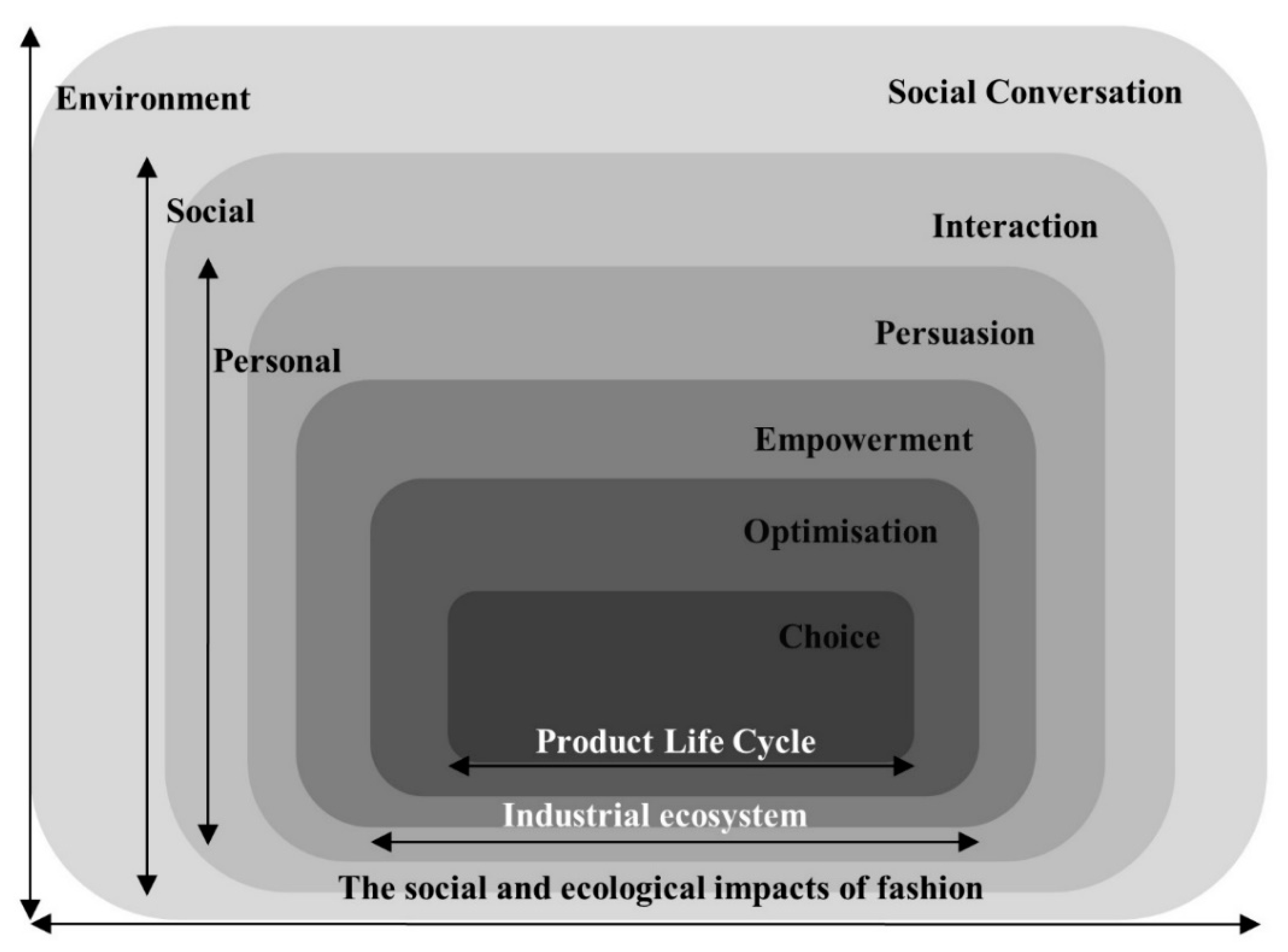
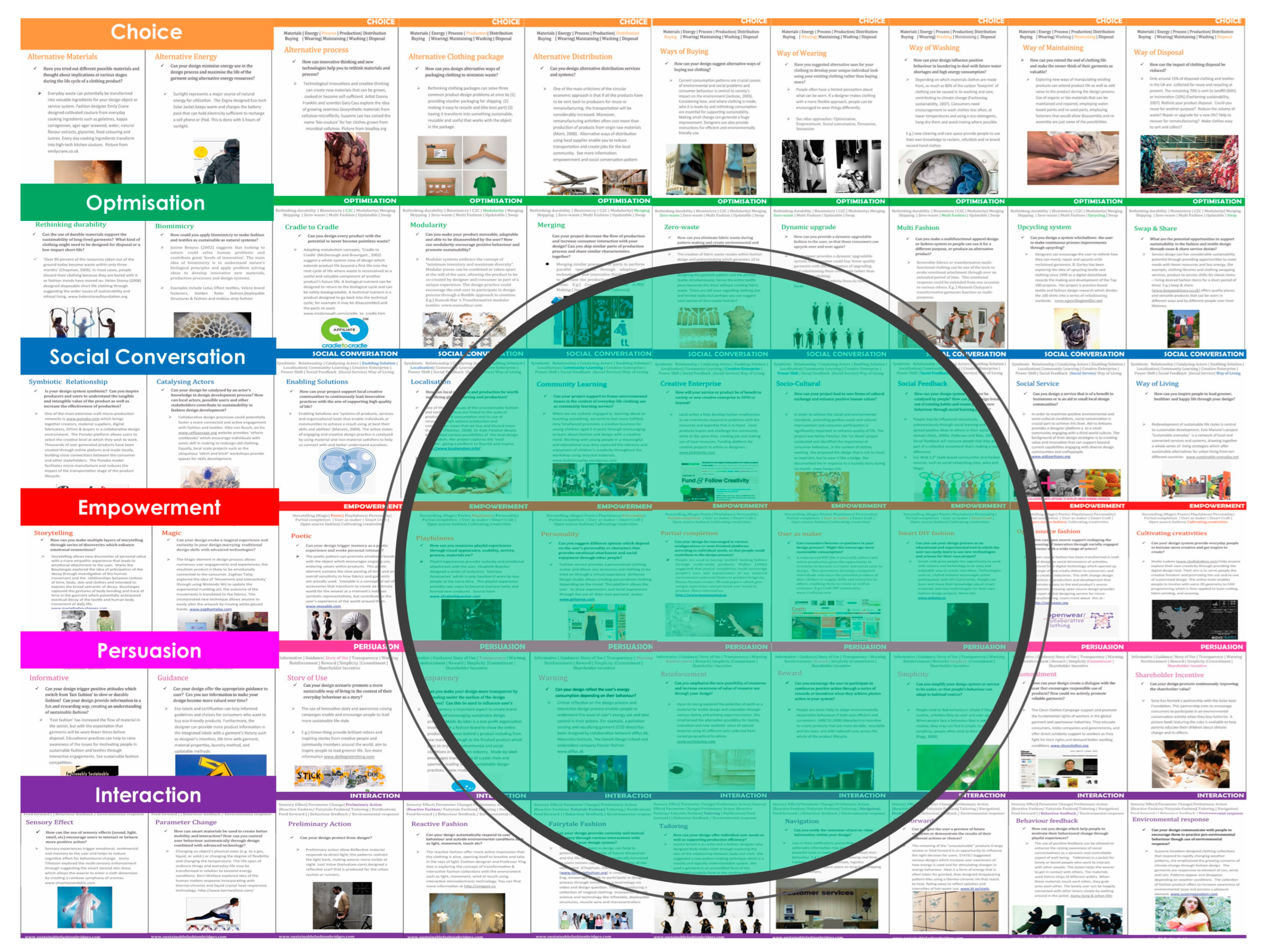
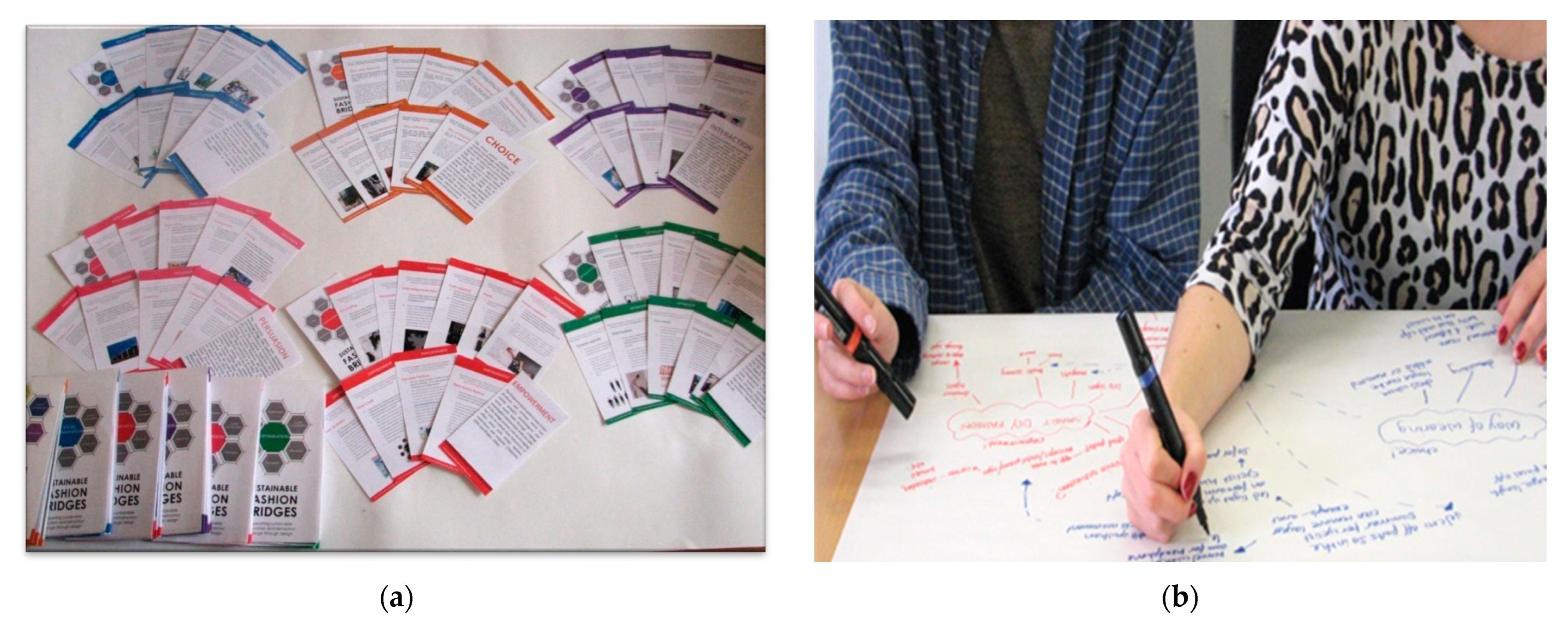
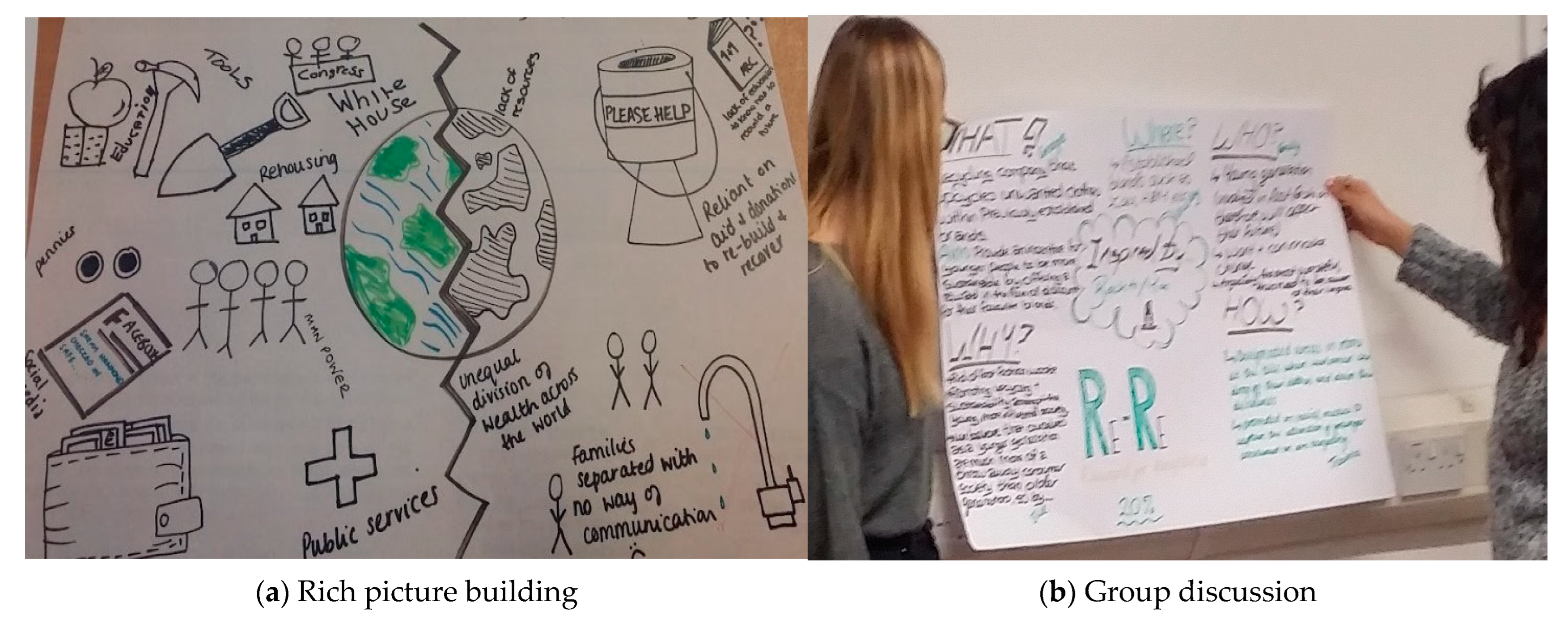
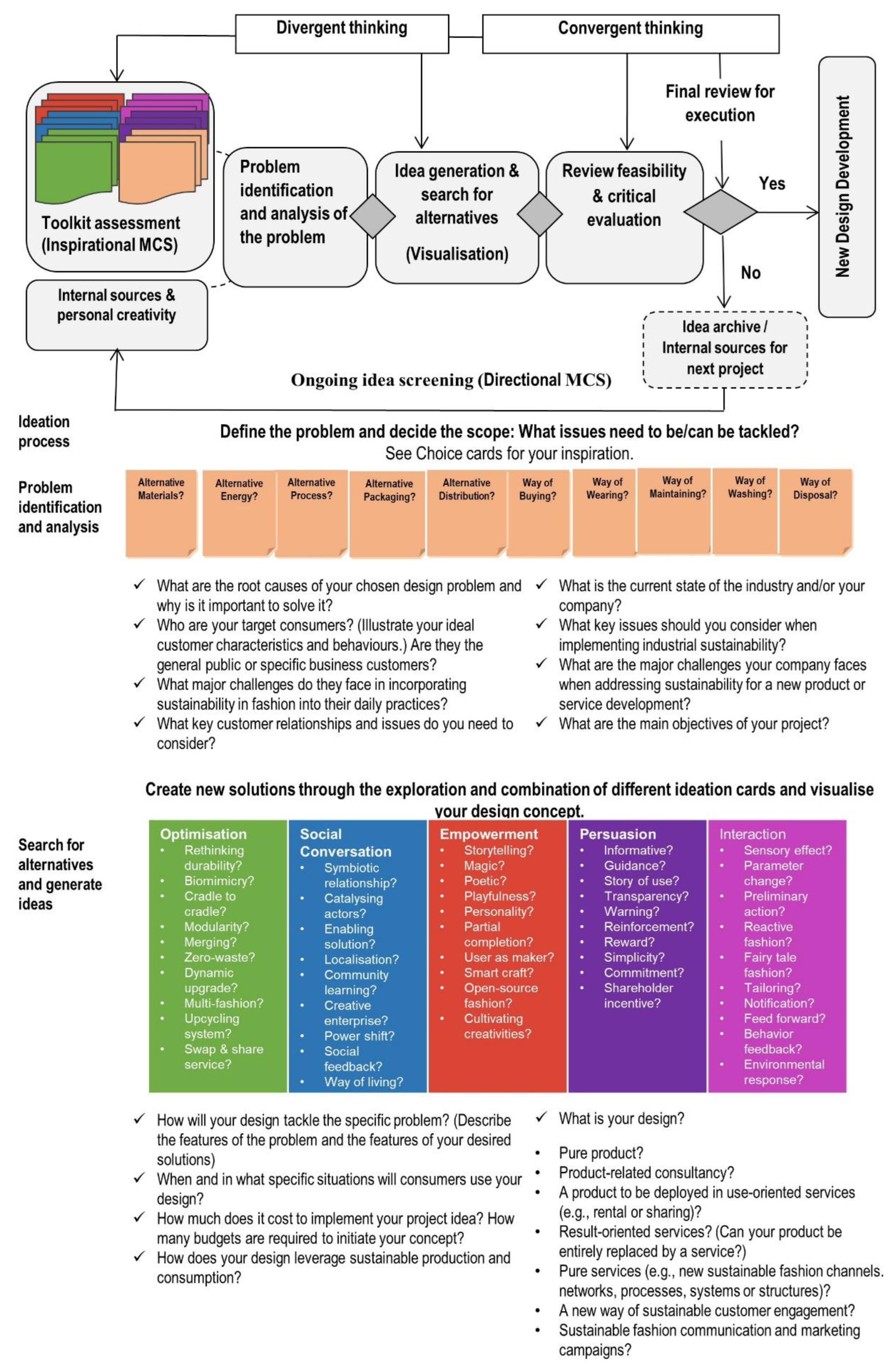
| Workshop No. | Participant Information |
|---|---|
| 1 | A co-design workshop with 5 participants of mixed backgrounds |
| 2 | A workshop with 17 fashion design (FD) students in the UK |
| 3 | A workshop with 18 FD students in the UK |
| 4 | A workshop with 17 design master’s students in the UK |
| 5 | A workshop with 28 fashion enterprise (FE) master’s students in the UK |
| 6 | A workshop with 27 fashion marketing (FM) students in the UK |
| 7 | A workshop with 25 FM students in the UK |
| 8 | A workshop with 10 fashion-related business start-up entrepreneurs and students in Seoul, Republic of Korea |
| Interviewees | Professional Background |
|---|---|
| Person (P) 1 | Head of CSR and sustainability from the outdoor sector |
| P2 | Creative director from a fashion textiles, homes, and jewellery brand |
| P3 | Senior marketer (senior account executive) from a fashion public relations and branding agency |
| P4 | Marketer (social media executive) from a public relations firm |
| P5 | Marketer from a luxury fashion brand |
| P6 | Fashion designer from a business-to-business consultancy |
| P7 | Fashion design lecturer from a university |
| P8 | Fashion marketing lecturer with several years’ industry experience of running fashion companies |
| P9 | Sustainable design lecturer |
| P10 | Fashion designer from a men’s clothing accessories company |
| P11 | Fashion management lecturer with several years’ experience as a fashion buyer |
| P12 | Design management lecturer |
| Themes | Sample Responses |
|---|---|
| Critical thinking: enabling development of critical thinking by offering problem-solving mechanisms regarding environmental and social issues in the overall clothing lifecycle |
|
| System thinking: helping understand the impacts of holistic system–thinking and how each action can influence the rest of the supply chain |
|
| Creativity and innovation: facilitating discussion of sustainability issues in fashion PSS design and triggering thought of what potential or alternative practices could exist for the future |
|
| Collaboration skills: supporting the creation of dialogue and communication of shared understanding within a group of people during the co-design workshop. |
|
| Themes | Sample Responses |
|---|---|
| Providing clear benefits: outlining the values of addressing sustainability in the fashion industry |
|
| Effective instructions: clear directional guidance on toolkit usage without a facilitator’s support |
|
| Personalisation and interactive tool: triggering actions for future sustainable design practices tailored to various user situations |
|
| Stimulating inspirations: visual content that inspires users to stimulate their imagination and encourage further discussion |
|
| Easily accessible digital tool: (e.g., a digital app or an interactive web platform) that could be more effectively employed to help individuals or teams to generate ideas. |
|
| Offering a reflective tool that enables an evaluation of toolkit users’ end outcomes for sustainable fashion practices |
|
Disclaimer/Publisher’s Note: The statements, opinions and data contained in all publications are solely those of the individual author(s) and contributor(s) and not of MDPI and/or the editor(s). MDPI and/or the editor(s) disclaim responsibility for any injury to people or property resulting from any ideas, methods, instructions or products referred to in the content. |
© 2023 by the authors. Licensee MDPI, Basel, Switzerland. This article is an open access article distributed under the terms and conditions of the Creative Commons Attribution (CC BY) license (https://creativecommons.org/licenses/by/4.0/).
Share and Cite
Hur, E.; Beverley, K. Fostering Sustainable Fashion Innovation: Insights from Ideation Tool Development and Co-Creation Workshops. Sustainability 2023, 15, 15499. https://doi.org/10.3390/su152115499
Hur E, Beverley K. Fostering Sustainable Fashion Innovation: Insights from Ideation Tool Development and Co-Creation Workshops. Sustainability. 2023; 15(21):15499. https://doi.org/10.3390/su152115499
Chicago/Turabian StyleHur, Eunsuk, and Katie Beverley. 2023. "Fostering Sustainable Fashion Innovation: Insights from Ideation Tool Development and Co-Creation Workshops" Sustainability 15, no. 21: 15499. https://doi.org/10.3390/su152115499
APA StyleHur, E., & Beverley, K. (2023). Fostering Sustainable Fashion Innovation: Insights from Ideation Tool Development and Co-Creation Workshops. Sustainability, 15(21), 15499. https://doi.org/10.3390/su152115499








